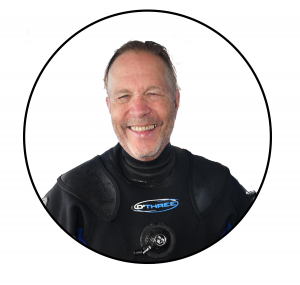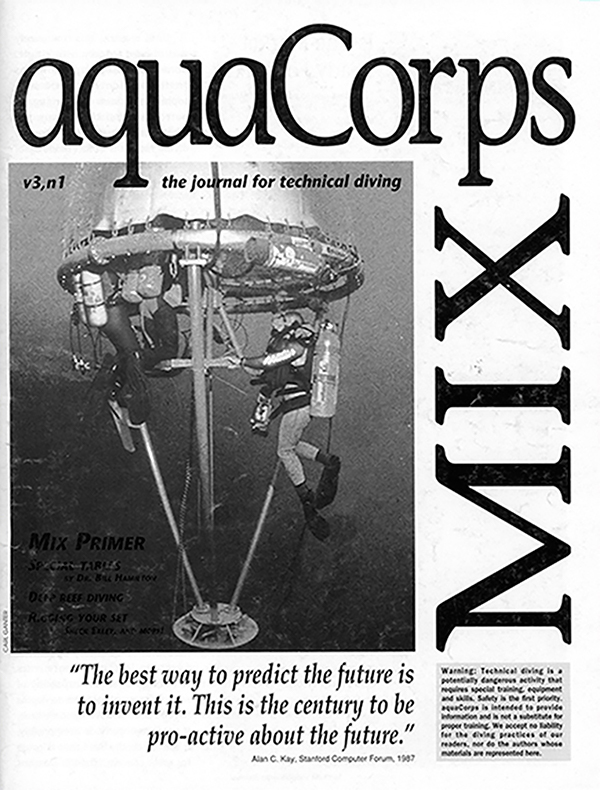Michael Menduno/M2

I launched aquaCORPS at the annual Diving Equipment & Marketing Association (DEMA) tradeshow held in Orlando, FL in January 1990. My goal was to provide detailed information on a new form of diving that was emerging within the sport diving community, which we soon dubbed, “technical diving.” And the name stuck. Though it got off to a precarious start, due to the number of early fatalities, tech diving eventually found its stride and has gone on to occupy its rightful place as the vanguard of sport diving.
Now on this 30th anniversary year of the birth of aquaCORPS, I am proud and excited to begin releasing the first digital reissues of the original magazine that helped foment the “Technical Diving Revolution.”
We plan to continue until all of the original issues of aquaCORPS and its sister publication technicalDIVER have been re-released in digital format. Note that the text in these digital issues is completely searchable. Use Adobe Reader for best results.
We want to extend a big THANK YOU to our sponsors who helped make this possible (see individual issue links below). Please show your appreciation by supporting them.
Thank you for your interest!
Michael Menduno
aquaCORPS 30th Anniversary speech at DEMA 2019

Issue #4|MIX
"The best way to predict the future is to invent it. This is the century to be pro-active about the future!"
Alan C. Kay, Stanford Computer Forum 1987
aquaCORPS #4 MIX was published in January 1992 just before the "Enriched Air Nitrox Workshop" chaired by Dr. RW Bill Hamilton that was held just prior to the Diving Equipment and Marketing Association (DEMA) show in Houston, Texas. The goal of the workshop, which was organized by aquaCORPS and the Scuba Diving Resources Group, was to bring together industry stakeholders to address concerns about nitrox use, and equipment compatibility and filling protocols. As a result of holding the workshop, DEMA allowed nitrox training agencies and vendors to attend the show.
The MIX issue focused on the adoption of mix gas diving technology by sport divers, and included an interview with cave explorer Sheck Exley. It was also the first issue of aquaCORPS that included the tagline, "The Journal for Technical Diving", a moniker coined by aquaCORPS founder & publisher Michael Menduno, and first used in 1991.
Download
Proudly sponsored by

Issue #5|BENT
"[Shit Happens] He smoothed down his lapel. "I always wear this pin at decompression meetings.” Dr. R. W. Bill Hamilton, NAUI ICUE 9OCT92.">Alan C. Kay, Stanford Computer Forum 1987
aquaCORPS #5 BENT was published in January 1993 in conjunction with the first technical diving conference, dubbed, tek.93, held just before the annual DEMA show in Orlando, Florida. The issue focused on decompression illness (DCI) and presented the latest thinking on the theory, classification, treatment, and human factors associated with DCI. It featured the work of some of the leading researchers in the field including; Carl Edmunds, T.J. R. Francis, RW Hamilton, Jennifer Hunt, Phillip James, CJ Lambertson, Surgical Capt. Pearson, Capt. Ed Thalmann, Richard Vann, and John Zumrick. At the time, DCI could easily be characterized as the "sexually transmitted disease (STD)" of sport diving. Like STDs, the affliction struck divers engaged in an activity that was fundamental to their nature. What's more there was a disproportionate fear and stigma surrounding DCI suggestive of a “moral disease," and a surprising lack of understanding regarding the disorder on the part of divers and the industry as a whole. We were concerned that we were likely to see more cases of DCI, as tech diving grew and divers continued to push our underwater envelope, by diving deeper and longer.
Download
Proudly sponsored by

Issue #6|COMPUTING
"
aquaCORPS #6 COMPUTING was published in June 1993 following aquaCORPS’ first technical diving conference, dubbed tek.93, held in Orlando, Florida in January of that year. The issue focused on dive computing and included interviews with nitrox computer developers Randy Bohrer (Bridge), Kevin Gurr (ACE), Paul Heinmiller (Phoenix), an interview with Karl Huggins (EDGE), and a story about commercial decompression software developed by decompression engineer, JP Imbert. There was also a review by Dr. Bill Hamilton and John Crea, of four desktop decompression programs that had recently been launched in the tech diving market. The cover of the issue shows a visualization of decompression risk that was rendered by David Story on a high-end Silicon Graphics workstation. In June 1993 there were no trimix diving computers. Instead, divers had to rely on pre-printed decompression tables such as the “Key West Consortium Tables,” generated by Hamilton and his DCAP program, or compute their own tables using one of the recently released desktop decompression software programs. COMPUTING went on to envision the future of dive computing with discussions of virtual and augmented reality systems, using computers to visualize decompression risk, and provided a tekkies’ guide to the newly emerging cyberspace and its implication for diving.
Download
Proudly sponsored by

Issue #7|C2
"Like so many devices which at the time of their of their invention were considered too revolutionary, there was but little demand for diving apparatus of this type for many years, Although my company has been making large numbers of breathing apparatus on this principle for work in poisonous atmospheres in mines, fire brigades, chemical works, gas works etc., the demand for its application to the diving dress was comparably small until the exigencies of war brought it into use and proved its value."
Robert H. Davis, Deep Diving and Submarine Operations 1951
aquaCORPS #7 C2 (Closed Circuit) was published in December 1993 just prior to the 1994 tek.Conference and DEMA show held in New Orleans, LA. The issue focused on rebreather technology, and we planned it as a primer in anticipation of aquaCORPS Rebreather Forum, scheduled to be held in Key West, FL that coming May. At the time, there was only a few dozen rebreather in the hands of sport divers including Cis-Lunar Development Laboratories MK-4 developed by Dr. Bill Stone, Carmellan Research’s modified Mk 15.5s developed by Stuart Clough, Steam Machine's PRISM prototypes designed by Peter Readey, French explorer Olivier Isler’s redundant semi-closed rebreather, and a number of modified military units. Rebreather training was still in its infancy.
Download
Proudly sponsored by















